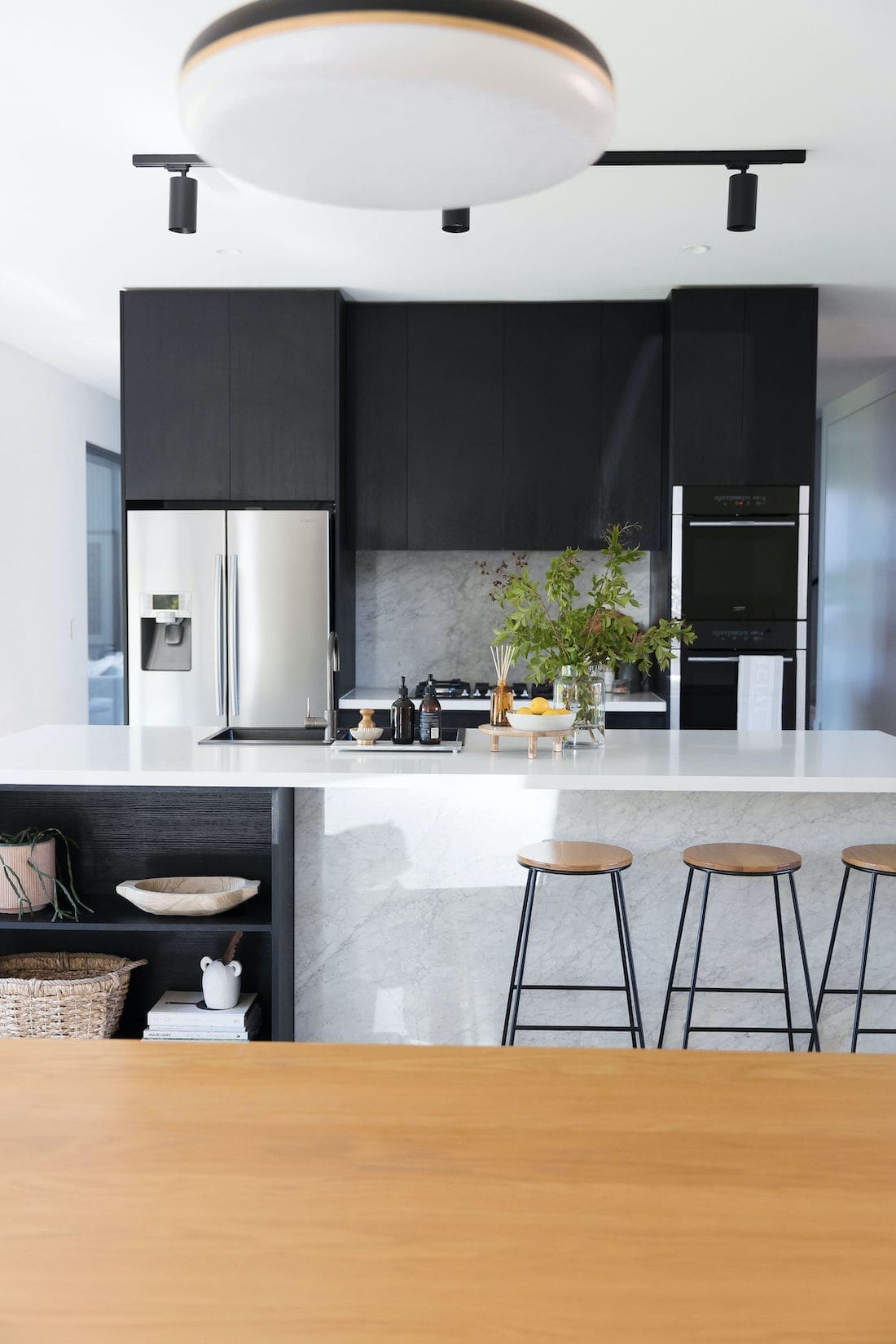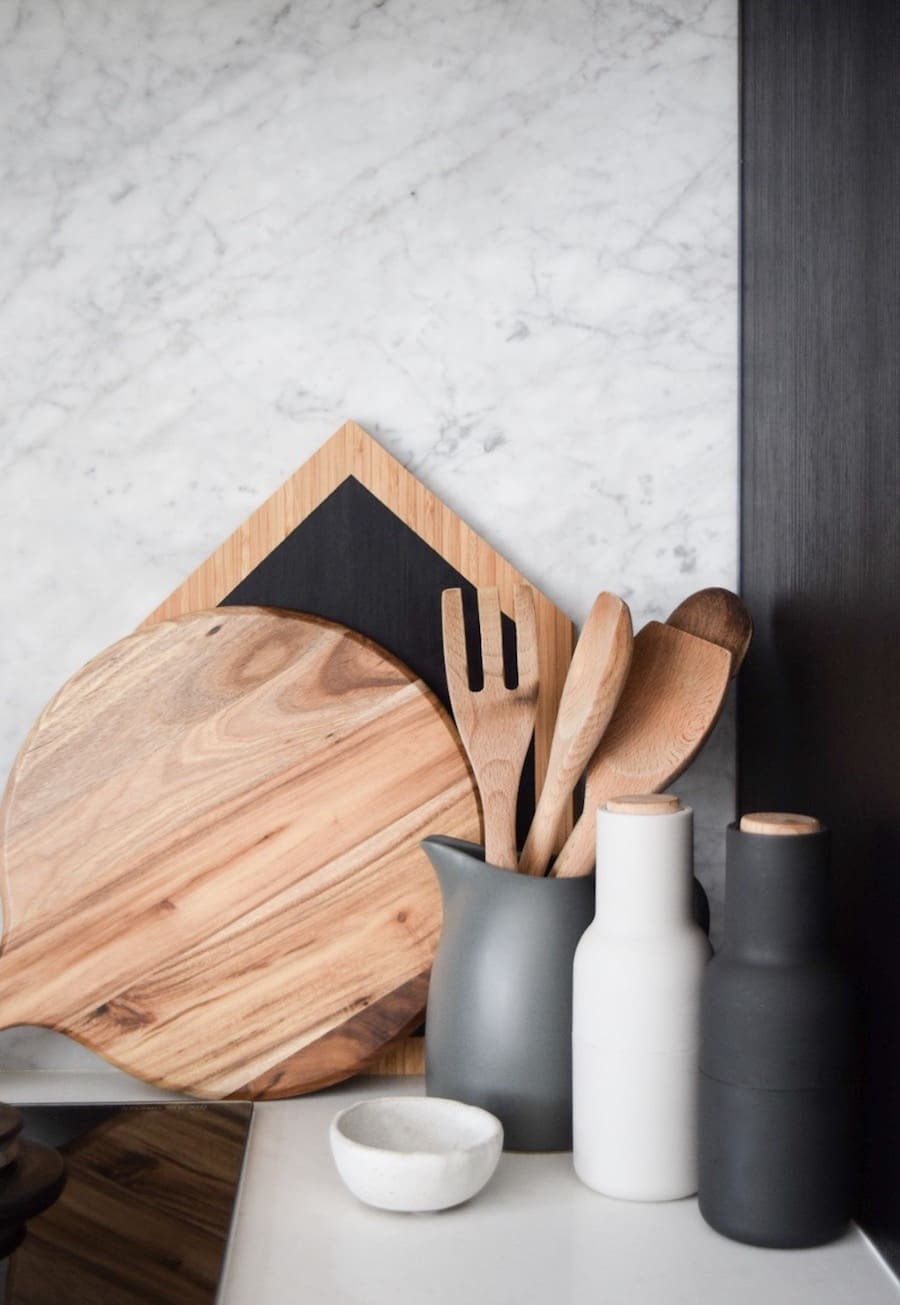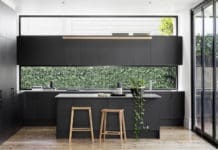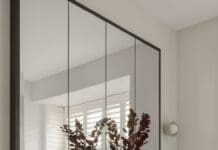When we were building our home, I had my heart set on a marble kitchen bench… but all I heard were horror stories about staining, chipping and other maintenance issues! So, I looked into other options. Ultimately, I decided on a combination of an engineered benchtop and natural marble splashback as it felt like a ‘safe’ way of using marble in the kitchen.
I still get questions to this day about whether or not marble is a good splashback material and if I regret my choice. So here’s my list of the pros and cons of using marble as a splashback material. Spoiler alert, I love it!
Related article: Gina’s home: Kitchen room reveal
Related article: Gina’s bathroom renovation reveal: Take a peek around my new bathroom

Pro: The natural beauty of stone
As much as engineered stone continues to advance, it just can’t quite match the depth and natural beauty of real stone. There are dozens of types of marble, ranging in colour and vein intensity. And because marble is naturally formed by compacted rocks, even two slabs of the same marble can look completely different.
The unique characteristics of natural marble is one of its biggest advantages and certainly the main reason I wanted to use it in my home.
Con: You need to be mindful about cleaning products
Just like all things of beauty, there’s generally a price to pay. And with natural marble, you need to be mindful about what cleaning products you use. If you love to splash bleach and harsh cleaners around, this probably isn’t the right splashback material for you.
That being said, all you need to use to clean natural marble is mild dish soap. Alternatively, you can use a natural surface spray, such as our soap based all-purpose cleaner here.
Pro: It’s more hardwearing than I thought!
Even though I got scared out of using marble benchtops, I was still nervous about using it as a splashback. So many people warned me about staining and discolouration.
We have the marble splashback right behind our cooktop and it’s constantly getting splattered with tomato sauce, wine, oil and there’s not a stain in sight.
I’m pleasantly surprised that marble is much more hardwearing than I thought and I would 100% use it again!

Con: There’s some required maintenance
Although marble is more hardwearing than I expected, it is still needs a little TLC. It’s essential to seal marble with a natural stone penetrating sealer. We used the Lithofin range, which is excellent and does not change the appearance of the stone at all.
It’s also recommended to reseal the stone once a year… but six years on, we haven’t resealed the marble and it still looks fab!
Pro: It can be cheaper than some tiles
Finally, another benefit of a slab of natural stone is that it can be more affordable than some decorative tiles. When you add up the cost of the tile per square metre, plus the cost for a tiler to install it, a solid slab of stone can work out to be less. Of course, it depends on what type of marble you’re considering, and what type of tile you’re comparing it against!
I hope these pros and cons of using marble as a kitchen splashback help you in your decision making. I’m so happy with our kitchen and thought it was worth sharing a positive story about marble in the kitchen. Because when I did my research, it was mainly negative and I nearly got scared off using marble altogether! However, there are also plenty of faux marble options out there such as engineered stone and large format porcelain tiles.
More design tips
This article was first published in August 2016 and continues to be updated with latest information.







Hi Gina, I’m renovating my kitchen soon and have been wanting to have a feature wall at the back of the induction stove using calacatta gold subway tiles 75x150mm size with 30% offset. For the benchtop, it’ll be Caesarstone. My question is about the splash back like yours, how has it held up over years of cooking and splattering? Tiling companies and builders have discouraged me from using it coz it’s not suitable for Asian cooking (greasy walls). They say the oil will seep into the marble even when it’s sealed.
Hi Merivale, I love our marble splashback. It’s been 6 years and it still looks gorgeous… and we only ever sealed it the one time (probably should do a touch up as they recommend doing it every year!). If you can use an epoxy grout though, that could save you potential headaches with grout. Many people use peroxide etc. to clean grout but when you have a natural marble tile, you need to use gentler cleaners… it may mean your grout discolours over time whereas epoxy grouts are virtually stain proof. Hope this helps 😉
Any recommendations for white kitchen. I’m planning to have white gloss canistry and marble natural finish on benchtop. Any recommendations for splashback? Is it ok for white gloss splashback?
Hi Revelina, personally I love the look of carrying the same stone up from the bench top to the splashback such as this home tour we featured https://stylecurator.com.au/modern-home-featuring-joinery-perfection/ (although the stone is Super White) or this example https://stylecurator.com.au/kitchen-before-and-after-navy-blue-kitchen/ (using Caesarstone marble) so if it were me, I’d use the same marble slab for the splashback.
If you have your heart sent on a tile though, it would be good to know more about the style you want to achieve or what other colours/finishes you have in your home. It is ok to use white gloss splashback although to soften the space, I’d be more inclined to go with a satin finish and something with a handmade or slightly organic texture. Hope this helps 🙂
I’m thinking of using marble as the kitchen splashback and quartz on the benchtop for practical reasons. How have you found the durability and practicality of this combination.
Hi Terese, I love this combination (although I have a Caesarstone benchtop). It’s great to have the low-maintenance option of the Caesarstone for the benchtop but the beauty of natural marble for the splashback. So long as you seal the marble with a quality sealer, such as Aqua-Seal Gold, it’s just a simple mater of wiping the marble clean with a damp cloth 🙂
Hello Gina
I have recently had a new laundry installed. Using Laminex Catalana Marble diamond gloss as the benchtop and parchment on doors. I have a black vinyl parquet floor… I never thought it would be so hard to decide on splashback but … it is. What would you suggest?
Hi AJ, could you please email a pic of your laundry to hello@stylecurator.com.au so we can take a look and make some suggestions? We’re working on a few splashback articles at the moment 🙂
Hi Gina My splashback area is 221cm cm x 52 cm high plus a small area at the side of the cooktop which is 69cm long x 52 cm high. I would love some tile ideas . Thank you
Help..I have a VERY small open plan unit and am renovating my tiny kitchen. I have a lot of light wood furniture and was thinking of using organic white Caesarstone island bench and around sink and splashback with 1/2 strength natural white on cupboards but worried it may be too bland and perhaps I would be better with mirror splashback or textured white tiles. I have a lot of colour in artwork and cushions and rug
Hi Julie-Anne, I really like the idea of using a mosaic white tile splashback that can add some texture to the space. How big is your splashback? I could email you some tile ideas if you like x
This is really helpful. Having used it on your splash back would you also consider getting a bench top out of it? I’m about to re-do my kitchen and have always loved the marble bench top look.
Ohhhh that’s a tough one Sarah! I certainly don’t think marble stains or chips as easily as some people say if you seal it properly and take a bit of care. Marble is more porous than Caesarstone and other man-made products but if you’re happy to roll with the natural beauty and accept it may discolour over time then yes, I probably would go with a natural stone benchtop. That being said, I think I much prefer the look of a white benchtop and marble splashback now that I have it 🙂
It’s always great to get feedback from real life situations.
Another quick question about the cabinetry colour. I love the black but have heard people remarking on fingerprints etc. How do you find yours?
Hey Amanda, good question! I’ve heard this about black cabinetry too but I think it applies to flat matte or gloss finishes. The black I’ve selected is a timber grain so it has a textured finish and fingerprints don’t show up at all. However, it does show oil marks (timber appears a bit darker where oil is) so I do need to clean the timber around the cooktop once a week or so. Hope this helps 🙂